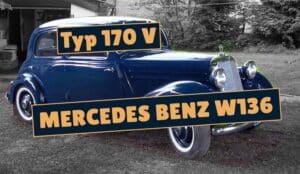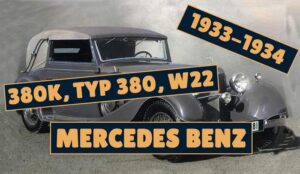Mercedes Benz 170 H W28 Origin
The Mercedes-Benz 170 H W-28 made its debut in February 1936 at the International Automobile and Motorcycle Exhibition in Berlin, Germany. The 170H was built in parallel with the W128 and the W136 but superseded these other two. This highly sophisticated 170 H W-w8 series was similar to the 170V with the significant difference in the position of their engines as the w-28 has its engine mounted at the rear as opposed to the 170H. The vehicle came both as a convertible and a saloon, just as its predecessor. The Mercedes -Benz 170 H W-28 was one of those cars that did well in specifications but somehow did not manage to do so well in the market; stay with me, and I’ll be glad to let you in on the details as we take a trip down memory lane as far back as the second world war.
Mercedes Benz 170 H W28 Overview
The Mercedes-Benz 170 H W-28, popularly called the Beetle, was designed as a rear-wheel-drive road car, with its powerplant installed in the rear, as well as a 4 door saloon body. Its engine type is a naturally aspirated petrol with a capacity of 1.7 liters, a total side valve of four cylinders with two cylinders per side. The W-28 has an output of 38 Boiler Horsepower, which is an equivalent of 28.3 kilowatts of the power unit at three thousand, four hundred revolutions per minute and a maximum torque of 100 Newton meters at one thousand, eight hundred revolutions per minute. The power of the vehicle is delivered to its wheels through a 4-speed manual transmission. The overall weight is claimed at one thousand, one hundred and twenty-five kilogram at the kerb, and its maximum speed is set at one hundred and ten kilometers per hour, an equivalent of sixty-five miles per hour.
The Mercedes-Benz 170 H W-28 was considered a very satisfactory car as it impressed its passengers with excellent suspension and noise comfort. In addition to these, another outstanding feature of the vehicle is the standard heating system that made it possible for the vehicle to regulate its heating system and turn it on and off as is required.
Mercedes Benz 170 H W28 Production
Production of the Mercedes-Benz 170 H W-28 spanned a period of four years from nineteen thirty-six through nineteen thirty-nine, and a total of one thousand, five hundred and seven vehicles were produced.
The Mercedes-Benz 170 H W-28 was one of the most sought-after vehicles during the second world war. Well, for some reasons, one of which included the fact the rear engine vehicles were not as used as their front-end counterparts, and they were also not suitable for the conversion to the wood gas generator, the vehicle was not confiscated by Wehrmacht. Rear engines vehicles used to be the perfect fit for the army until the Volkswagen-based Kübelwagen started off its war career in Russia and Africa.
Although the Mercedes-Benz 170 H W-28 was considered a more sophisticated car than the 170V, it still did not do too well in the market well as compared to the 170V; some of these reasons included the fact that the 170v came with more body variants, providing buyers with a plethora of choices, another factor that made the Mercedes-Benz 170 H W-28 sell less was its RM 600 which had a higher price tag as compared to the 170v. The number of productions of the 170v was over sixty-seven thousand in total. Today, the Mercedes-Benz 170 H W-28 is still considered one of the rarest and arguably the most sought-after vintage car.
Mercedes Benz 170 H W28 Price
The Mercedes-Benz 170 H W-28, like I said earlier, is one of the rarest of the Mercedes-Benz cars ever produced, but not totally unavailable per se; a recent auction held for the vehicle was sold for fifty-nine thousand, one hundred and ninety-eight dollars. Well, the Germans have quite the reputation when it comes to Automobile production, right? So, if you’re willing to get one of these, if you’re lucky to find one, you better have your credit card loaded for this one.
That’s all for today guys, I’m sure you loved this article, so hit that share button, and stay tuned for more classic car articles.

![You are currently viewing Mercedes Benz 170 H W28 [the Beetle] (1936 – 1939)](https://classicsdude.com/wp-content/uploads/2021/08/Mercedes-Benz-170-H-W-28-website.jpg)


